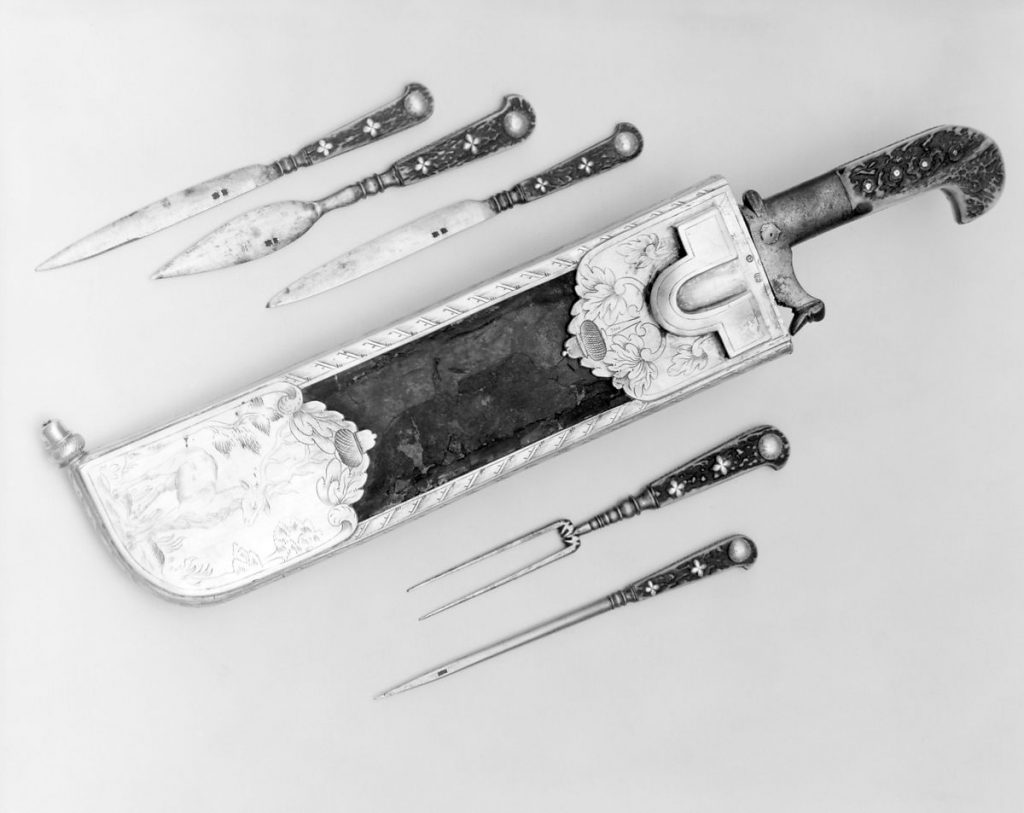We’re going to depart from firearms this time, but we’ll be staying in the realm of hunting, so not too far off.
Hunting was a very different thing in Europe in 16th-17th C. Generally speaking it was restricted to the members of the political and social upper-crust. A gentleman might fire the gun, but dealing with the results was often why a game-keeper was employed. They were not merely there to serve during the hunt of course; in day-to-day life they were a combination of Hunting Guide, steward and park ranger for their employer’s estate.
Hunting was a social occasion often enough, and like most such occasions it was an excuse to re-affirm ones wealth and good taste. One way to express this was by embellishing the tools of the hunt. Guns, crossbows, knives etc. were lovely to see, and were often inlaid with precious metals, Ivory or Mother of Pearl. Carrying or providing your gamekeeper with impressive tools was a mark of distinction. Among those tools was the Trousse de Chasse, a set of knives and other tools for skinning and processing kills. While we might expect they employed more pedestrian tools in their daily life, on a formal hunt they needed to impress, and this meant these sets were often richly ornamented. It is unclear if these tools were used by the principle or the servants, or if that varied by time and place, or even on an individual basis.

These sets often included one or more skinning knives, a large knife referred to as a ‘cleaver’ for jointing or quartering game, an awl for stitching the meat up in the hide for transport and a two-tined fork for… uh, because fork. Some sets included a saw, a stiletto or other tools as well as the basics. Both the set and the common sheath that held it were embellished with silver or gold mounts and engraving.
I first saw pictures of these sets when I was in High School, and was fascinated. I thought ‘wouldn’t it be great to make on of these sets?’ Many years later when I became a knifemaker I often thought about making one, but such a thing would be rather expensive and take a lot of time… time that was hard to come by while making a living.
The thing is I haven’t seen anyone do a credible reproduction of one of these sets, and only one that might be is far enough enough off the mark that I’m not positive they were trying for a Trousse de Chasse.
Finally in 2020 I decided ‘to heck with it… I’m gonna make one!’ So I did. This required getting some antler, which is hard to come by in the correct size etc. around here. I’ve ordered antler online and generally been unhappy with what I got, but there is a solution; there’s a store just off the highway in Montesano that often has antler racks for sale, and it’s only a two-hour drive…
OK, time to get started. First I regretfully decided that my engraving skills are not yet up to the task. I decided to start with a rather pedestrian set with all the right pieces, but not elaborately decorated.
The cleaver was first, made from 1/4″ thick 5160 spring steel. The three deep fullers (grooves) on each side of the blade were a pain, but the result is worth it. I fitted it with brass bolsters and antler scales secured with brass rivets.
The two skinning knives were made from 1/8″ O-1 tool steel with antler scales riveted to the tags on either side. The fork is made from O-1 drill-rod stock and the Awl is from 1/2″ O-1 also. The awl is double edged and quite sharp; it has no trouble punching through leather. All of the knives, the fork and awl were heat-treated and quenched in Olive oil, then tempered in the oven to the mid-50s Rockwell hardness. The fork was drawn to a full spring temper, around HRc48.
The fork and awl have blind tangs inserted into sections of the antler from near the tips, with brass ferrules at the base to prevent splitting. Now for the sheath, which is a whole ‘nuther thing.
The sheath needed to be made from multiple layers of hardwood, all based on the cleaver, with another layer for the knives and a third for the fork and awl. I made this by cutting out the shapes of the blade from 1/4″ spruce then thinning them down appropriately before adding the next layer. After it was glued up I shaped the sheath carefully, tapering it in thickness towards the tip. That done I covered it in chrome-tanned garment leather and added a brass band sound the sheathes holding the tools. Light friction between the various handles keeps everything nicely in place.
I gotta’ say, it’s chunky; the whole set weights about 2-1/2 pounds. But the long-held goal was accomplished, and I would be happy to have it along on a hunt. The various tools will work as well as they ever did, and the cleaver would help a great deal with an improvised blind or similar chores.
Sadly I will not have that opportunity. Despite my misgivings about being able to find a buyer (not the least due to the price) it sold immediately. Maybe I should have charged more…
I need to work on my non-ferrous metal-smithing skills to make more elaborate fittings for the scabbard on the next one, and I am continuing to practice engraving. Yes, there’s going to be a next one, even if I never sell it. I want to document the process more, especially the sheath-making. Also it was interesting to make and I learned a thing or two, but more importantly these things are cool.
Stay safe and take care.
Michael Tinker Pearce, 29 April 2021
If you like what you see here, please consider clicking the link above and supporting me on Patreon.